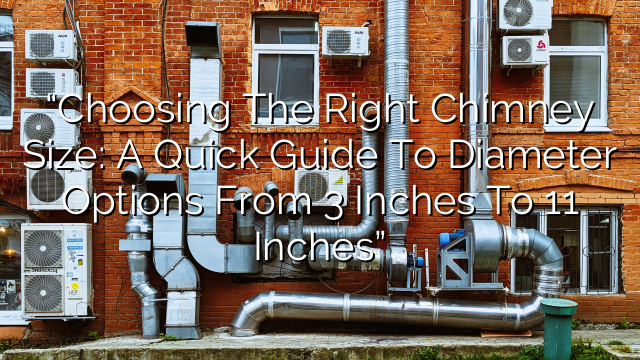When it comes to installing a chimney or replacing an existing one, choosing the right diameter is crucial. The size of the chimney you select will impact the overall performance of your fireplace or wood-burning stove. It affects the efficiency, draft, and safety of your heating system. In this guide, we will walk you through the different diameter options available for chimney products, ranging from 3 inches to 11 inches. Understanding these options will help you make an informed decision for your specific needs.
Why Does Chimney Diameter Matter?
The diameter of a chimney impacts its overall efficiency and performance in several ways:
- Draft: The diameter of a chimney affects the draft, which is the flow of air through the flue system. A properly sized chimney facilitates the smooth passage of combustion gases, allowing for efficient combustion and preventing smoke backdraft.
- Condensation: A chimney that is too large for the heating appliance can contribute to condensation issues. The excess space in the flue allows for the accumulation of moisture and acidic byproducts, which can lead to corrosion and damage to the chimney system.
- Efficiency: The right chimney size ensures optimal efficiency by maintaining a proper balance between the amount of exhaust gases produced by the heating appliance and the size of the flue. This helps to prevent heat loss and ensures the maximum heat output from your fireplace or stove.
- Safety: A properly sized chimney minimizes the risk of chimney fires and carbon monoxide leaks. When the flue is the correct diameter, it can effectively contain and remove the byproducts of combustion.
Diameter Options: 3 Inches to 11 Inches
Now that we understand the importance of chimney diameter, let’s take a closer look at the available options:
3 Inches
A 3-inch chimney diameter is commonly used for small heating appliances and pellet stoves. These types of heating systems require a specialized flue system that can handle the combustion byproducts associated with burning pellets. It’s important to note that 3-inch chimneys are not suitable for wood-burning fireplaces or larger stoves.
4 Inches
A 4-inch chimney diameter is often used for direct vent, gas, or pellet stoves with smaller heat outputs. These chimneys are compact and offer adequate draft for small heating appliances. However, they are generally not recommended for larger wood-burning fireplaces or higher heat output stoves.
5 Inches
A 5-inch chimney diameter is commonly used for gas fireplaces, small wood-burning stoves, or as an exhaust vent for some vented gas heating appliances. These chimneys are versatile and suitable for moderate heat outputs. They offer a good balance between draft performance and space requirements.
6 Inches
A 6-inch chimney diameter is one of the most common options for wood-burning fireplaces and stoves. It provides adequate draft for medium-sized heating appliances and is suitable for most residential applications. A 6-inch chimney is often recommended as a standard choice unless specific circumstances dictate otherwise.
8 Inches
An 8-inch chimney diameter is typically used for large wood-burning fireplaces or stoves with higher heat outputs. These chimneys are designed to handle the larger volume of exhaust gases produced by bigger heating appliances. An 8-inch chimney ensures effective venting and helps to maintain optimal efficiency and safety.
11 Inches
An 11-inch chimney diameter is reserved for large commercial heating systems or industrial applications. These chimneys are designed to handle the heavy-duty requirements of high-capacity heating units or industrial processes. They have oversized flues to accommodate the large volume of exhaust gases.
FAQs
1. How do I determine the correct chimney diameter for my heating appliance?
The correct chimney diameter depends on various factors, including the type of heating appliance, heat output, and local building codes. It’s best to consult with a professional chimney installer or a qualified heating technician who can assess your specific requirements and recommend the appropriate chimney size for your needs.
2. Can I use a larger chimney diameter than what is recommended?
While it may be tempting to use a larger chimney diameter for increased draft, it is not recommended. A larger chimney can create draft problems, leading to poor combustion, reduced efficiency, and potential safety hazards. It’s best to follow the manufacturer’s guidelines and consult with professionals to ensure proper chimney sizing.
3. Can I use a smaller chimney diameter than what is recommended?
Using a smaller chimney diameter than what is recommended can significantly impact the performance and safety of your heating system. A smaller chimney may not provide adequate draft, leading to smoke backdraft, incomplete combustion, and increased risk of chimney fires. It’s crucial to install the correct chimney size for your heating appliance.
4. Can I install a chimney system myself?
It is highly recommended to hire a professional chimney installer to ensure proper installation, sizing, and compliance with local building codes and safety regulations. Professional chimney installers have the necessary expertise and experience to design and install a chimney system that meets your specific needs and ensures optimal performance and safety.
5. Are there any specific maintenance requirements for chimneys?
Regular chimney maintenance is essential to ensure optimal performance and prevent chimney fires and carbon monoxide leaks. It is recommended to schedule annual chimney inspections and cleanings by a certified chimney sweep. Additionally, it’s important to follow the manufacturer’s guidelines for maintenance and operation of your heating appliance.
Conclusion
Choosing the right chimney size is a critical decision that directly affects the efficiency, performance, and safety of your heating appliance. By considering factors such as the type of heating system, heat output, and local building codes, you can select the appropriate chimney diameter for your specific needs. Remember, consulting with professionals and following manufacturer’s guidelines is essential to ensure proper chimney sizing and installation. A well-sized chimney will provide efficient draft, optimal performance, and peace of mind for years to come.









